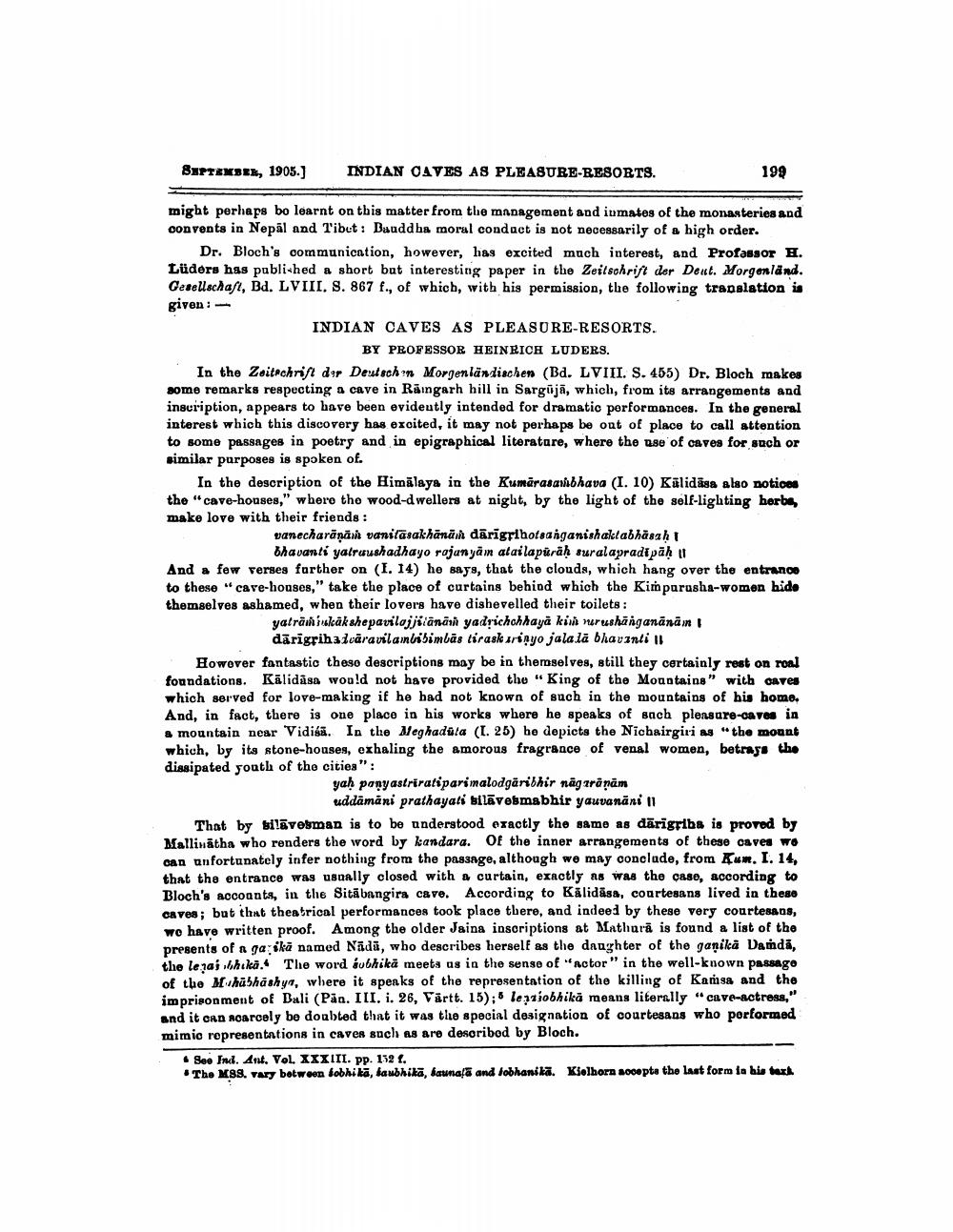________________
SIPTEMBER, 1905.)
INDIAN CAVES AS PLEASURE-RESORTS.
199
might perhaps bo learnt on this matter from the management and iumates of the monasteries and convents in Nepal and Tibet: Bauddba moral conduct is not necessarily of a high order.
Dr. Bloch's communication, however, has excited much interest, and Profassor H. Lüders has published a short but interesting paper in the Zeitschrift der Deut. Morgenland. Gesellschaft, Bd. LVIII. S. 867 f., of which, with his permission, the following translation is given:
INDIAN CAVES AS PLEASURE-RESORTS.
BY PROFESSOR HEINRICH LUDERS. In the Zoitschrift der Deutschn Morgenländischen (Bd. LVIII. S. 455) Dr. Bloch makes some remarks respecting a cave in Rāingarh hill in Sargūjā, which, from its arrangements and insuription, appears to have been evideutly intended for dramatic performances. In the general interest which this discovery has excited, it may not perhaps be out of place to call attention to some passages in poetry and in epigraphical literatare, where the use of caves for such or similar purposes is spoken of.
In the description of the Himalaya in the Kumārasambhava (I. 10) Külidass also notices the "cave-houses," where the wood-dwellers at night, by the light of the self-lighting herbe, make love with their friends :
vanecharāņāih vanitāsakhānām dārīgflhotsa nganishaktabhasah
bhavanti yatruushadhayo rajanyan alai lapäräh suralapradipah 11 And a few verses further on (I. 14) he says, that the clouds, which hang over the entrance to these care-houses," take the place of curtains behind which the Kimparasha-women hide themselves ashamed, when their lovers have dishevelled their toilets :
yaträniukākshepavilojjitānāin yadrichchhaya kiin nerushänganānan
dārigrihalvāravilambibimbās tirask arinyo jala la bhavinli Il Howover fantastic theso descriptions may be in themselves, still they certainly rest on roal foundations. Kālidāsa would not have provided the "King of the Mountains" with caves which served for love-making if he had not known of such in the mountains of his home. And, in fact, there is one place in his works where he speaks of sach pleasure-caves in a mountain near Vidiśä. In the Meghadula (I. 25) he depicts the Nichairgiri as "the mount which, by its stone-houses, exhaling the amorous fragrance of venal women, betrays the dissipated youth of the cities":
yah panyastriratiparimalodgäribhir nagaranam
uddämari prathayali bilāvesmabhir yauvanāni 11 That by bilāvesman is to be understood exactly the same as dārigrlbs is proved by Mallivātha who renders the word by kandara. Of the inner arrangements of these caves wo can unfortunately infer nothing from the passage, although we may conclude, from Kum. I. 14, that the entrance was usually closed with a curtain, exactly as was the case, according to Bloch's accounts, in the Sitābangira cave. According to Kālidāsa, courtesans lived in these Caves; but that theatrical performances took place there, and indeed by these very courtesans, we have written proof. Among the older Jaina inscriptions at Mathurā is found a list of the presents of ga ikā named Nāda, who describes herself as the daughter of the ganika Danda, the leaj bhika. The word kubhikā meets us in the sense of actor" in the well-known passage of the Mhabhäshyn, where it speaks of the representation of the killing of Kamga and the imprisonment of Bali (Pān. III. i. 26, Värtt. 15): 8 leptíobhikā means literally “cave-actress," and it can noarcely be doubted that it was the special designation of courtesans who porformed mimio representations in caves such as are describod by Bloch.
Seo Indl. Ant. Vol. XXXIII. pp. 152 t. • The M88. vary between fobhikā, laubhikā, launafā and Jobhanika. Kjelhorn accepta the last form in his tech




